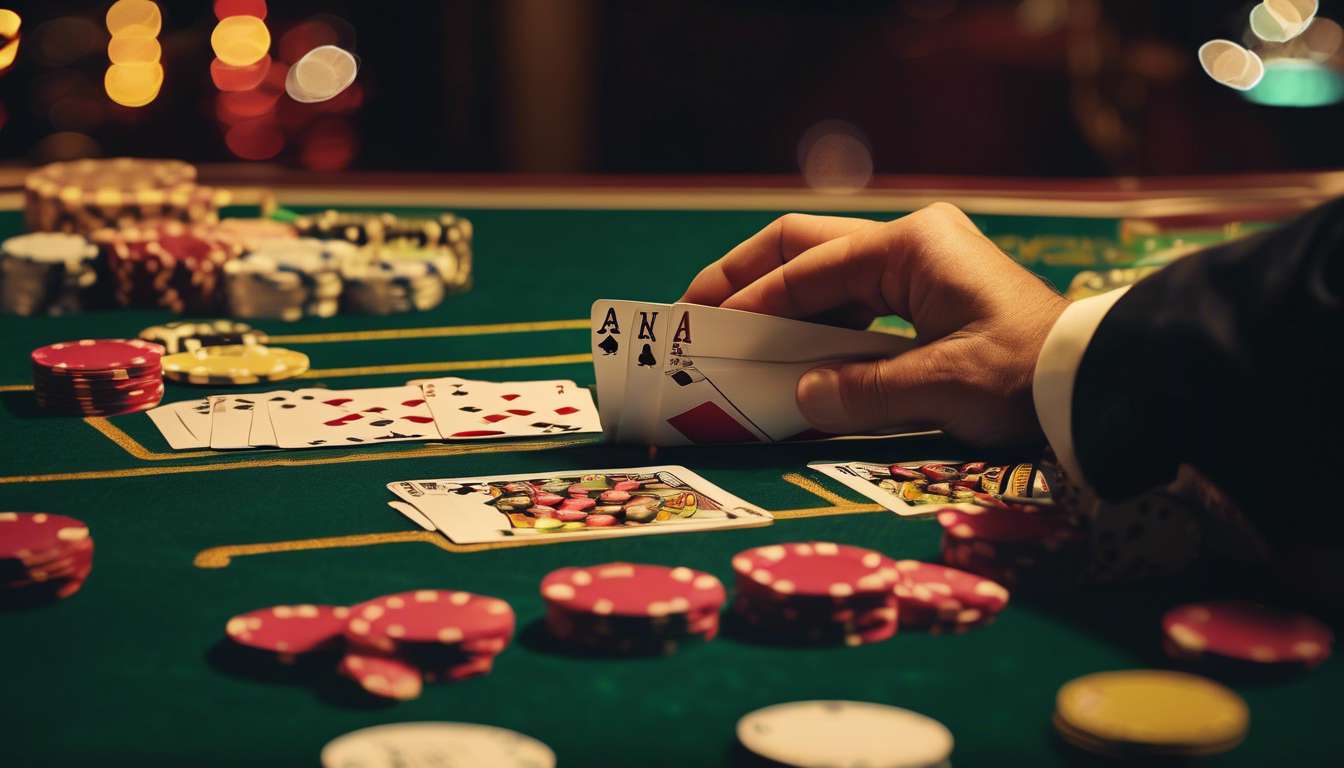As blackjack enthusiasts, we’ve all felt the thrill that comes with holding a winning hand at the table. However, understanding what makes a blackjack hand strong or weak is crucial if we want to improve our game and increase our chances of success.
In this article, we will explore the essential elements that contribute to the strength or vulnerability of our hands. Together, we’ll delve into the significance of:
- Card values
- The dealer’s upcard
- Strategic decisions that can make or break our game
By examining various scenarios and strategies, we aim to demystify the complexities of blackjack, empowering us to make informed decisions and enhance our gameplay.
Whether we’re seasoned players or newcomers to the game, gaining a deeper understanding of these elements will:
- Boost our confidence
- Add to the enjoyment of each hand we play
Let’s embark on this journey to master the nuances of blackjack strategy.
Importance of Card Values
Understanding Card Values in Blackjack
In blackjack, knowing the card values is essential for making strategic decisions during gameplay. Each card holds specific values that guide players through each round:
- Face cards are valued at 10.
- Aces can flexibly count as either 1 or 11.
This versatility with aces provides a strategic advantage when deciding the next move.
Mastering Basic Strategy
By mastering the basic strategy, players align themselves with the collective wisdom of experienced players. This strategy offers guidelines on:
- When to hit.
- When to stand.
- When to double down.
Doubling down becomes particularly powerful when the player’s hand totals 10 or 11, offering strong potential against the dealer.
Shared Goals and Strategy
Our shared goal as a community of players is to make informed decisions, maximizing our chances of winning. Embracing these card values and strategies not only enhances our gameplay but also unites us in our pursuit of victory.
Impact of Dealer’s Upcard
One of the critical factors in making successful decisions in blackjack is analyzing the dealer’s upcard to adjust our strategy accordingly. The card values the dealer reveals significantly influence our choices, helping us feel like savvy members of the blackjack community.
When the dealer shows a strong card, like a 7 or higher:
- It’s vital to play cautiously.
- Their odds of forming a solid hand are high.
Conversely, if the dealer’s upcard is weak, like a 4, 5, or 6:
- We can gain confidence.
- There is a higher chance they might bust.
Our basic strategy becomes more dynamic when we consider the dealer’s upcard.
For instance, when holding a total of 10 or 11, and the dealer shows a lower card, we might seize the opportunity to double down, aiming to capitalize on their potential weakness.
By aligning our decisions with these strategies, we enhance our sense of belonging in the blackjack world, making informed, strategic plays.
Role of Aces in Hand Strength
Aces in Blackjack
Aces are versatile powerhouses in blackjack, transforming our hands by acting as either 1 or 11, depending on our strategic needs. This flexibility is what makes aces so crucial to our game. When we draw an ace, we instantly feel a sense of camaraderie with fellow players, knowing we’ve got a pivotal card that can shift our hand’s strength.
Card Values and Strategy
The card values are vital here as aces adapt, giving us the edge to adjust our total effectively. By following basic strategy, we can maximize the potential of our aces. Whether we’re aiming for a blackjack or considering our options for doubling down, aces provide us with a strategic advantage.
Decision-Making and Confidence
In situations where we hold an ace, we’re more agile in decision-making, allowing us to respond to the dealer’s moves with confidence. Understanding the role of aces ensures we can play our hands wisely, enhancing our shared experience at the table.
Understanding Hard and Soft Hands
In blackjack, understanding the distinction between hard and soft hands is crucial for making informed decisions during gameplay. This knowledge helps us feel like a part of the blackjack community, where everyone appreciates the nuances of card values and strategies.
Hard Hands occur when:
- Our hand doesn’t contain an Ace.
- The Ace counts as one point to avoid busting.
Example: A 10 and 7 form a hard 17.
Soft Hands, on the other hand, include:
- An Ace that can be counted as 11 without busting.
Example: An Ace and a 6 for a soft 17.
Knowing the difference affects our basic strategy:
- With a soft hand, we’ve got more flexibility, allowing us to consider doubling down without the same risk of busting.
- Meanwhile, hard hands require a more cautious approach.
By mastering these concepts, we strengthen our connection to the game and each other, making us feel more confident at the table. Let’s embrace this knowledge and play smarter together!
Utilizing Basic Strategy Charts
To make informed decisions while playing blackjack, we should leverage basic strategy charts that outline optimal moves based on our hand and the dealer’s upcard. By doing so, we’re not just playing solo; we’re aligning ourselves with a community of players who understand the importance of strategy.
These charts help us interpret card values effectively, guiding us on when to:
- Hit
- Stand
- Double down
Basic strategy offers a sense of belonging, as we follow a shared path to success. It’s like having a map in the sprawling landscape of blackjack, ensuring we don’t get lost in the shuffle. Knowing when to double down can significantly impact our hand’s strength, and these charts are our guide.
By using basic strategy, we’re not relying on luck alone. Instead, we’re making calculated decisions that boost our chances of winning, connecting us with others who appreciate the game’s intricacies.
Let’s embrace this approach and play smarter together.
Significance of Doubling Down
Doubling down is a powerful move that can significantly increase our potential winnings in blackjack when executed at the right moment. By doubling our original bet after receiving our first two cards, we’re seizing an opportunity to capitalize on favorable card values. This move isn’t just about taking risks—it’s part of a calculated approach grounded in basic strategy, a guide many of us use to navigate the complexities of blackjack.
Key considerations for doubling down:
- Acknowledge the strength of our hand.
- Recognize the dealer’s potential weaknesses.
- Basic strategy suggests considering doubling down when:
- Our initial hand totals 10 or 11.
- The dealer shows a weaker card.
Such situations present us with an edge, one we can exploit to our advantage.
Together, as a community of blackjack enthusiasts, we can appreciate the thrill and camaraderie that comes with mastering these strategies. Embracing doubling down isn’t just about winning; it’s about belonging to a group that values skill and calculated decision-making.
When to Hit or Stand
Deciding When to Hit or Stand in Blackjack
Deciding when to hit or stand is crucial in blackjack, as it directly impacts our chances of beating the dealer. We’ve all been there, sitting at the table, feeling the camaraderie with fellow players, trying to evaluate our hand’s strength. Using card values and basic strategy, we make these pivotal decisions.
Basic Strategy for Hitting or Standing:
- When our hand totals between 12 and 16:
- If the dealer shows a card between 7 and Ace, basic strategy suggests we should hit. This minimizes the risk of going bust while increasing the chance to improve our hand.
- If the dealer shows a weak card (2 through 6), standing might be wiser, letting the dealer risk busting instead.
Doubling Down:
Doubling down adds another layer of excitement and strategy. When we hold a total of 10 or 11, doubling down can maximize our potential, especially if the dealer shows a lower card.
By following these strategies, we strengthen our community of knowledgeable players, enhancing our collective experience at the table.
Maximizing Splitting Opportunities
Splitting pairs in blackjack can significantly boost our odds, especially when we know which hands to divide for maximum advantage. By understanding card values and following basic strategy, we can transform potentially weak hands into opportunities for profit.
Recommended Splits:
- Aces: Splitting Aces gives us a fresh start with high potential, as each Ace can lead to a strong hand.
- 8s: Splitting 8s helps avoid the dreaded 16, a notoriously weak hand.
Strategic Benefits:
Our community knows that splitting isn’t just about doubling our bet; it’s about doubling our chances. When we split with the right strategy, we open the door to doubling down, further increasing our potential payout.
Pairs to Avoid Splitting:
- 10s: Already a strong hand, so better to maintain the advantage.
- 5s: Offer better opportunities with a single hit or double.
By mastering these splitting tactics, we’re not just playing a game; we’re playing with purpose and camaraderie, enhancing our collective blackjack experience.
How does the number of decks used in a game affect the strength of a blackjack hand?
When we consider the number of decks used in a blackjack game, it directly impacts the strength of our hands.
With more decks:
- Our chances of getting certain cards decrease.
- It becomes harder to form strong hands.
Conversely, with fewer decks:
- The likelihood of receiving favorable cards increases.
- Our hand strength is boosted.
Thus, the number of decks plays a crucial role in determining the strength of our blackjack hands.
What psychological factors can influence a player’s perception of hand strength in blackjack?
When playing blackjack, our perception of hand strength is influenced by various psychological factors.
Emotional Influences:
- Emotions such as confidence or fear can significantly impact how we view the cards we’re dealt.
- Past experiences, whether positive or negative, may also shape our perception of the current hand.
Social Influences:
- The presence of other players at the table can affect our decision-making process.
- The dealer’s expressions and body language might unconsciously influence our assessment of our hand.
Importance of Awareness:
- Being aware of these psychological and social influences is crucial.
- Understanding these factors can help us make more informed and rational decisions during the game.
By recognizing and managing these influences, players can improve their strategic approach to blackjack.
How do side bets impact the overall strength and strategy of a blackjack hand?
When we consider side bets in blackjack, these additional wagers can significantly influence the dynamics of the hand.
Benefits of Side Bets:
- They introduce extra excitement.
- They offer potential for increased winnings.
Risks of Side Bets:
- They come with increased risk.
- They may tempt players to deviate from their usual gameplay strategy.
It’s important to approach side bets cautiously. Weigh the potential rewards against the additional risks they bring to the table to ensure a balanced and strategic gameplay experience.
Conclusion
In conclusion, mastering the nuances of blackjack hand strength involves several key considerations:
- Card Values: Understanding the value of each card in your hand.
- Dealer’s Upcard: Analyzing the dealer’s visible card to inform your decisions.
- Strategic Decisions: Knowing when to double down or split your cards.
By understanding when to hit, stand, or utilize basic strategy charts, you can increase your chances of success at the blackjack table.
Remember, practice and experience are key in improving your gameplay and making the most of each hand dealt to you.
Good luck at the tables!

